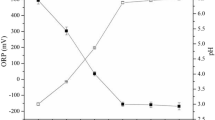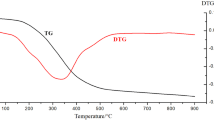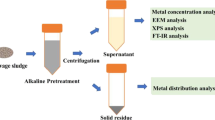Abstract
Liquefaction of sewage sludge (SS) in ethanol-water cosolvents is a promising process for the preparation of bio-oil/biochar products. Effect of the combined use of ethanol and water on the distribution/transformation behaviors of heavy metals (HMs) contained in raw SS is a key issue on the safety and cleanness of above liquefaction process, which is explored in this study. The results show that pure ethanol facilitates the migration of HMs into biochar products. Pure water yields lower percentages of HMs in mobile/bioavailable speciation. Compared with sole solvent treatment, ethanol-water cosolvent causes a random/average effect on the distribution/transformation behaviors of HMs. After liquefaction of SS in pure water, the contamination degree of HMs is mitigated from high level (25.8 (contamination factor)) in raw SS to considerable grade (13.4) in biochar and the ecological risk is mitigated from moderate risk (164.5 (risk index)) to low risk (78.8). Liquefaction of SS in pure ethanol makes no difference to the pollution characteristics of HMs. The combined use of ethanol and water presents similar immobilization effects on HMs to pure water treatment. The contamination factor and risk index of HMs in biochars obtained in ethanol-water cosolvent treatment are 13.1−14.6 (considerable grade) and 79.3−101.0 (low risk), respectively. In order to further control the pollution of HMs, it is preferentially suggested to improve the liquefaction process of SS in ethanol-water mixed solvents by introducing conventional lignocellulosic/algal biomass, also known as co-liquefaction treatment.
摘要
污水厂污泥在乙醇-水混合溶剂中液化是制备生物油/生物炭的一种有前景的方法。乙醇和水联 合使用对污泥液化过程中重金属的迁移和转化行为的影响是有关上述液化技术的安全性和清洁性方 面的重要课题。本论文针对这一课题展开了研究,结果表明:纯乙醇作为液化溶剂时,重金属向生物 炭迁移的比例更高;纯水作为液化溶剂时,生物炭中活性态重金属的比例则更低;与单一溶剂液化相 比,乙醇-水共溶剂对重金属的分布和转化行为的影响呈现随机效应或平均效应。污泥在纯水中液化 后,重金属的污染程度由生原污泥的重度污染(污染指数25.8)降低到生物炭的中度-重度污染(污染指 数13.4),生态风险则由中等风险(风险指数164.5)降低到低风险(风险指数78.8)。纯乙醇作为液化溶剂 时对重金属的污染程度和生态风险影响甚微。乙醇和水的联合使用具有和纯水类似的重金属钝化效 应。污泥在乙醇-水混合溶剂中液化所得的生物炭中重金属的污染指数和风险指数分别是13.1~14.6(中 度-重度污染)和79.3~101.0(低风险)。为了进一步控制基于乙醇-水混合溶剂污泥液化过程中重金属的 污染,可以通过在污泥液化过程中引入常规的木质纤维素或藻类生物质(也即采用共液化技术)。
Similar content being viewed by others
References
SYED-HASSAN S S A, WANG Yi, HU Song, SU Sheng, XIANG Jun. Thermochemical processing of sewage sludge to energy and fuel: Fundamentals, challenges and considerations [J]. Renewable and Sustainable Energy Reviews, 2017, 80: 888–913. DOI: https://doi.org/10.1016/j.rser.2017.05.262.
REN Miao-miao, YUAN Xing-zhong, ZHU Yi, HUANG Hua-jun, ZENG Guang-ming, LI Hui, CHEN Ming, WANG Hou, CHEN Chang-ya, LIN Ning-bo. Effect of different surfactants on removal efficiency of heavy metals in sewage sludge treated by a novel method combining bio-acidification with Fenton oxidation [J]. Journal of Central South University, 2014, 21(12): 4623–4629. DOI: 10.1007/s11771-014-2469-3.
KACPRZAK M, NECZAJ E, FIJALKOWSKI K, GROBELAK A, GROSSER A, WORWAG M, RORAT A, BRATTEBO H, ALMÅS Å, SINGH B R. Sewage sludge disposal strategies for sustainable development [J]. Environmental Research, 2017, 156: 39–46. DOI: https://doi.org/10.1016/j.envres.2017.03.010
QIAN Li-li, WANG Shu-zhong, XU Dong-hai, GUO Yang, TANG Xing-ying, WANG Lai-sheng. Treatment of municipal sewage sludge in supercritical water: A review [J]. Water Research, 2016, 89: 118–131. DOI: https://doi.org/10.1016/j.watres.2015.11.047
MULCHANDANI A, WESTERHOFF P. Recovery opportunities for metals and energy from sewage sludges [J]. Bioresource Technology, 2016, 215: 215–226. DOI: https://doi.org/10.1016/j.biortech.2016.03.075.
OUYANG Jian-xin, SHI Zhou, ZHONG Hua, LIU Wei, CHAI Qi, YUAN Xing-zhong. Static aerobic composting of municipal sewage sludge with forced ventilation: Using matured compost as bulking conditioner [J]. Journal of Central South University, 2014, 21(1): 303–309. DOI: 10.1007/s11771-014-1941-4.
HUANG Hua-jun, YUAN Xing-zhong. Recent progress in the direct liquefaction of typical biomass [J]. Progress in Energy and Combustion Science, 2015, 49: 59–80. DOI: https://doi.org/10.1016/j.pecs.2015.01.003.
LIANG Jia-lin, HUANG Shao-song, DAI Yong-kang, LI Lei, SUN Shui-yu. Dewaterability of five sewage sludges in Guangzhou conditioned with Fenton’s reagent/lime and pilot-scale experiments using ultrahigh pressure filtration system [J]. Water Research, 2015, 84: 243–254. DOI: https://doi.org/10.1016/j.watres.2015.07.041.
MO Ru-song, HUANG Shao-song, DAI Wen-can, LIANG Jia-lin, SUN Shui-yu. A rapid Fenton treatment technique for sewage sludge dewatering [J]. Chemical Engineering Journal, 2015, 269: 391–398. DOI: https://doi.org/10.1016/j.cej.2015.02.001.
BILLER P, JOHANNSEN I, DOS-PASSOS J S, OTTOSEN L D M. Primary sewage sludge filtration using biomass filter aids and subsequent hydrothermal co-liquefaction [J]. Water Research, 2018. 130: 58–68. DOI: https://doi.org/10.1016/j.watres.2017.11.048
MA Wen-chao, DU Gui-yue, LI Jian, FANG Yuan-hao, HOU Li-an, CHEN Guan-yi, MA De-gang. Supercritical water pyrolysis of sewage sludge [J]. Waste Management, 2017, 59: 371–378. DOI: https://doi.org/10.1016/j.wasman.2016.10.053.
QIAN Li-li, WANG Shu-zhong, SAVAGE P E. Hydrothermal liquefaction of sewage sludge under isothermal and fast conditions [J]. Bioresource Technology, 2017, 232: 27–34. DOI: https://doi.org/10.1016/j.biortech.2017.02.017.
MALINS K, KAMPARS V, BRINKS J, NEIBOLTE I, MURNIEKS R, KAMPARE R. Bio-oil from thermochemical hydro-liquefaction of wet sewage sludge [J]. Bioresource Technology, 2015, 187: 23–29. DOI: https://doi.org/10.1016/j.biortech.2015.03.093.
WANG Yan, CHEN Guan-yi, LI Yan-bin, YAN Bei-bei, PAN Dong-hui. Experimental study of the bio-oil production from sewage sludge by supercritical conversion process [J]. Waste Management, 2013, 33(11): 2408–2415. DOI: https://doi.org/10.1016/j.wasman.2013.05.021.
VARDON D R, SHARMA B K, SCOTT J, YU G, WANG Z C, SCHIDEMAN L, ZHANG Y H, STRATHMANN T J. Chemical properties of biocrude oil from the hydrothermal liquefaction of Spirulina algae, swine manure, and digested anaerobic sludge [J]. Bioresource Technology, 2011, 102(17): 8295–8303. DOI: https://doi.org/10.1016/j.biortech.2011.06.041.
LENG Li-jian, LI Jun, YUAN Xing-zhong, LI Jing-jing, HAN Pei, HONG Yu-chun, WEI Feng, ZHOU Wen-guang. Beneficial synergistic effect on bio-oil production from co-liquefaction of sewage sludge and lignocellulosic biomass [J]. Bioresource Technology, 2018, 251: 49–56. DOI: https://doi.org/10.1016/j.biortech.2017.12.018.
LENG Li-jian, YUAN Xing-zhong, SHAO Jian-guang, HUANG Hua-jun, WANG Hou, LI Hui, CHEN Xiao-hong, ZENG Guang-ming. Study on demetalization of sewage sludge by sequential extraction before liquefaction for the production of cleaner bio-oil and bio-char [J]. Bioresource Technology, 2016, 200: 320–327. DOI: https://doi.org/10.1016/j.biortech.2015.10.040.
LI Hui, YUAN Xing-zhong, ZENG Guang-ming, HUANG Dan-lian, HUANG Hua-jun, TONG Jing-yi, YOU Qiao, ZHANG Jia-chao, ZHOU Ming. The formation of bio-oil from sludge by deoxy-liquefaction in supercritical ethanol [J]. Bioresource Technology, 2010, 101(8): 2860–6. DOI: https://doi.org/10.1016/j.biortech.2009.10.084.
HUANG Hua-jun, YUAN Xing-zhong, LI Bao-tong, XIAO Yuan-dong, ZENG Guang-ming. Thermochemical liquefaction characteristics of sewage sludge in different organic solvents [J]. Journal of Analytical and Applied Pyrolysis, 2014, 109: 176–184. DOI: https://doi.org/10.1016/j.jaap.2014.06.015.
HUANG Hua-jun, YUAN Xing-zhong, ZHU Hui-na, LI Hui, LIU Yan, WANG Xue-li, ZENG Guang-ming. Comparative studies of thermochemical liquefaction characteristics of microalgae, lignocellulosic biomass and sewage sludge [J]. Energy, 2013, 56: 52–60. DOI: https://doi.org/10.1016/j.energy.2013.04.065.
LAI Fa-yin, CHANG Yan-chao, HUANG Hua-jun, WU Guo-qiang, XIONG Jiang-bo, PAN Zhi-qian, ZHOU Chun-fei. Liquefaction of sewage sludge in ethanol-water mixed solvents for bio-oil and biochar products [J]. Energy, 2018, 148: 629–641. DOI: https://doi.org/10.1016/j.energy.2018.01.186.
WANG Wen-jia, YU Qi, MENG Han, HAN Wei, LI Jie, ZHANG Jing-lai. Catalytic liquefaction of municipal sewage sludge over transition metal catalysts in ethanol-water co-solvent [J]. Bioresource Technology, 2018, 249: 361–367. DOI: https://doi.org/10.1016/j.biortech.2017.09.205.
PRAJITNO H, PARK J, RYU C, PARK H Y, LIM H S, KIM J. Effects of solvent participation and controlled product separation on biomass liquefaction: A case study of sewage sludge [J]. Applied Energy, 2018, 218: 402–416. DOI: https://doi.org/10.1016/j.apenergy.2018.03.008.
HUANG Hua-jun, YUAN Xing-zhong. The migration and transformation behaviors of heavy metals during the hydrothermal treatment of sewage sludge [J]. Bioresource Technology, 2016, 200: 991–998. DOI: https://doi.org/10.1016/.biortech.2015.10.099.
HUANG Hua-jun, YUAN Xing-zhong, ZENG Guang-ming, ZHU Hui-na, LI Hui, LIU Zhi-feng, JIANG Hong-wei, LENG Li-jian, BI Wen-kai. Quantitative evaluation of heavy metals’ pollution hazards in liquefaction residues of sewage sludge [J]. Bioresource Technology, 2011, 102(22): 10346–10351. DOI: https://doi.org/10.1016/j.biortech.2011.08.117.
YUAN Xing-zhong, HUANG Hua-jun, ZENG Guang-ming, LI Hui, Wang Jing-yu, ZHOU Chun-fei, ZHU Hui-na, PEI Xiao-kai, LIU Zhi-feng, LIU Zhan-tao. Total concentrations and chemical speciation of heavy metals in liquefaction residues of sewage sludge [J]. Bioresource Technology, 2011, 102(5): 4104–10. DOI: https://doi.org/10.1016/j.biortech.2010.12.055.
ZHAI Yun-bo, CHEN Hong-mei, XU Bi-bo, XIANG Bo-bin, CHEN Zhong, Li Cai-ting, ZENG Guang-ming. Influence of sewage sludge-based activated carbon and temperature on the liquefaction of sewage sludge: Yield and composition of bio-oil, immobilization and risk assessment of heavy metals [J]. Bioresource Technology, 2014, 159: 72–79. DOI: https://doi.org/10.1016/j.biortech.2014.02.049.
CHEN Hong-mei, ZHAI Yun-bo, XU Bi-bo, XIANG Bo-bin, ZHU Lu, QIU Lei, LIU Xiao-ting, LI Cai-ting, ZENG Guang-ming. Fate and risk assessment of heavy metals in residue from co-liquefaction of Camellia oleifera cake and sewage sludge in supercritical ethanol [J]. Bioresource Technology, 2014, 167: 578–581. DOI: https://doi.org/10.1016/j.biortech.2014.06.048.
LENG Li-jian, LENG Song-qi, CHEN Jie, YUAN Xing-zhong, LI Jun, LI Kun, WANG Yun-pu, ZHOU Weng-guang. The migration and transformation behavior of heavy metals during co-liquefaction of municipal sewage sludge and lignocellulosic biomass [J]. Bioresource Technology, 2018, 259: 156–163. DOI: https://doi.org/10.1016/j.biortech.2018.03.019.
LENG Li-jian, YUAN Xing-zhong, HUANG Hua-jun, JIANG Hong-wei, CHEN Xiao-hong, ZENG Guang-ming. The migration and transformation behavior of heavy metals during the liquefaction process of sewage sludge [J]. Bioresource Technology, 2014, 167: 144–150. DOI: https://doi.org/10.1016/j.biortech.2014.05.119.
YUAN Xing-zhong, LENG Li-jian, HUANG Hua-jun, CHEN Xiao-hong, WANG Hou, XIAO Zhi-hua, ZHAI Yun-bo, CHEN Hong-mei, ZENG Guang-ming. Speciation and environmental risk assessment of heavy metal in bio-oil from liquefaction/pyrolysis of sewage sludge [J]. Chemosphere, 2015, 120: 645–652. DOI: https://doi.org/10.1016/j.chemosphere.2014.10.010.
SHAO Jian-guang, YUAN Xing-zhong, LENG Li-jian, HUANG Hua-jun, JIANG Long-bo, WANG Hou, CHEN Xiao-hong, ZENG Guang-ming. The comparison of the migration and transformation behavior of heavy metals during pyrolysis and liquefaction of municipal sewage sludge, paper mill sludge, and slaughterhouse sludge [J]. Bioresource Technology, 2015, 198: 16–22. DOI: https://doi.org/10.1016/j.biortech.2015.08.147.
HUANG Hua-jun, YANG Ting, LAI Fa-yin, WU Guo-qiang. Co-pyrolysis of sewage sludge and sawdust/rice straw for the production of biochar [J]. Journal of Analytical and Applied Pyrolysis, 2017, 125: 61–68. DOI: https://doi.org/10.1016/j.jaap.2017.04.018.
YANG Ting, HUANG Hua-jun, LAI Fa-yin. Pollution hazards of heavy metals in sewage sludge from four wastewater treatment plants in Nanchang, China [J]. Transactions of Nonferrous Metals Society of China, 2017, 27(10): 2249–2259. DOI: 10.1016/S1003-6326(17)60251-6.
ZHAO Shou, FENG Cheng-hong, YANG Yi-ru, NIU Jun-feng, SHEN Zhen-yao. Risk assessment of sedimentary metals in the Yangtze Estuary: New evidence of the relationships between two typical index methods [J]. Journal of Hazardous Materials, 2012, 241-242: 164–172. DOI: https://doi.org/10.1016/j.jhazmat.2012.09.023.
IKEN A, EGIEBOR N O, NYAVOR K. Trace elements in water, fish and sediment from Tuskegee lake, southeastern USA [J]. Water, Air, and Soil Pollution, 2003, 149: 51–75. DOI: https://doi.org/10.1023/a:1025694315763.
CHANAKA-UDAYANGA W D, VEKSHA A, GIANNNIS A, LISAK G, CHANG V W C, LIM T T. Fate and distribution of heavy metals during thermal processing of sewage sludge [J]. Fuel, 2018, 226: 721–744. DOI: https://doi.org/10.1016/j.fuel.2018.04.045.
SHI Wan-sheng, LIU Chun-guang, SHU You-ju, FENG Chuan-ping, LEI Zhong-fang, ZHANG Zhen-ya. Synergistic effect of rice husk addition on hydrothermal treatment of sewage sludge: Fate and environmental risk of heavy metals [J]. Bioresource Technology, 2013, 149: 496–502. DOI: https://doi.org/10.1016/j.biortech.2013.09.114.
GB/T 24600-2009. China’s Ministry of Housing and Urban-Rural Consruction. Disposal of sludge from municipal wastewater treatment plant? Quality of sludge used in land improvement [S]. (in Chinese)
LIM M C H, AYOKO G A, MORAWSKA L, RISTOVSKI Z D, JAYARATNE E R. The effects of fuel characteristics and engine operating conditions on the elemental composition of emissions from heavy duty diesel buses [J]. Fuel, 2007, 86(12): 1831–1839. DOI: https://doi.org/10.1016/j.fuel.2006.11.025
YLLDLRLM G, TOKALLOGLU S. Heavy metal speciation in various grain sizes of industrially contaminated street dust using multivariate statistical analysis [J]. Ecotoxicology and Environmental Safety, 2016, 124: 369–376. DOI: https://doi.org/10.1016/j.ecoenv.2015.11.006.
LIANG Xin, NING Xun-an, CHEN Guo-xin, LIN Mei-qing, LIU Jing-yong, WANG Yu-jie. Concentrations and speciation of heavy metals in sludge from nine textile dyeing plants [J]. Ecotoxicology and Environmental Safety, 2013, 98: 128–134. DOI: https://doi.org/10.1016/j.ecoenv.2013.09.012.
FUENTES A, LLORÉNS M, SÁEZ J, AGUILAR M I, ORTUÑO J F, MESEGUER V F. Comparative study of six different sludges by sequential speciation of heavy metals [J]. Bioresource Technology, 2008, 99(3): 517–525. DOI: https://doi.org/10.1016/j.biortech.2007.01.025.
SHI Wan-sheng, LIU Chun-guang, DING Da-hu, LEI Zhong-fang, YANG Ying-nan, FENG Chuang-ping, ZHANG Zhen-ya. Immobilization of heavy metals in sewage sludge by using subcritical water technology [J]. Bioresource Technology, 2013, 137: 18–24. DOI: https://doi.org/10.1016/j.biortech.2013.03.106.
NAZARI L, YUAN Zhong-shun, RAY M B, XU Chun-bao. Co-conversion of waste activated sludge and sawdust through hydrothermal liquefaction: Optimization of reaction parameters using response surface methodology [J]. Applied Energy, 2017, 203: 1–10. DOI: https://doi.org/10.1016/j.apenergy.2017.06.009.
Author information
Authors and Affiliations
Corresponding authors
Additional information
Foundation item: Project(21707056) supported by the National Natural Science Foundation of China; Project(20151BAB213024) supported by the Natural Science Foundation of Jiangxi Province, China; Project(GJJ14302) supported by the Scientific Research Fund of Jiangxi Provincial Education Department, China
Rights and permissions
About this article
Cite this article
Pan, Zq., Huang, Hj., Zhou, Cf. et al. Distribution and transformation behaviors of heavy metals during liquefaction process of sewage sludge in ethanol-water mixed solvents. J. Cent. South Univ. 26, 2771–2784 (2019). https://doi.org/10.1007/s11771-019-4212-6
Received:
Accepted:
Published:
Issue Date:
DOI: https://doi.org/10.1007/s11771-019-4212-6




